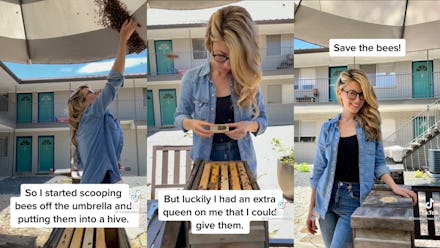TikTok's favorite beekeeper is getting dragged for "faking" it

Jerry Seinfeld could never. There’s a little bit of bee drama on the timeline today, and not because a bumble bee is trying to romance Renee Zelwegger. (Simpler times, right?) A video of Bee TikTokker Erika Thompson (@texasbeeworks) circulated on Twitter yesterday, and users were impressed by her serene, ASMR-ready voice and calm approach to removing bees from beneath an umbrella.
Thompson, in glasses, long blonde hair, and a jean jacket, tackles the swarming bees and picks them up with her hand to place them in the hive she brought. She narrates the video in a near whisper, noting that the bees had no resources or progeny to protect. As she kept scooping bees off of the umbrella, she says, “By the time I removed most of the bees, I still had not seen the queen; and I realized this was an unusual case of a queenless swarm.”
She pops out from her breast pocket a Queen Bee in a little cage, savvy and cool, saying “This colony would not survive without a queen… But luckily, I had an extra queen on me that I could give them!” Well, isn’t she something, so resourceful! She coolly describes the process through which a colony will accept or reject a queen, “If they didn’t accept her, they would try to kill her. If they did accept her, they would release her from the box by chewing through a piece of candy that stops up one end.” All is successful! The swarm moves to the new hive, and Thompson brings the hive to her apiary, ending the video on a somewhat self-congratulatory note, the text reading “Save the bees!” over a photo of her posing next to her hive, as she says, “It was another great day of saving the bees!”
As the bee epidemic continues, with record numbers of colonies collapsing and the cases worsening in the pandemic, interest in bees has grown on social media. There’s endless Bee Movie memes, and enough of a niche community to thrive on other platforms like TikTok and Instagram. Here, the casual self-satisfaction (probably unintentional) delighted people on Twitter.
But there’s some understandable criticism to take into account concerning this video, and Thompson’s broader relaxed approach and methodology to removing a swarm. A TikTok user whose account, @lahoneybeerescue has been deleted, pointed out that going in to handle a swarm “with her hair down, wearing dark clothes, with exposed skin is dangerous.” The user, whose video was saved and posted by Twitter user @diligenda and reposted by New York Times tech reporter Taylor Lorenz, continues, “She doesn’t show herself wearing protective gear when she goes up and [analyzes] the hive.” She also makes points about the length of Thompson’s hair, saying that most female beekeepers cut their hair or keep it in a bun in order to avoid bees getting trapped in the hair and stinging the person’s neck or face. The user asserts that Thompson’s husband has cut the honey comb for her, and stresses that the fact that Thompson approaches these removals without the right gear and tools “set[s] a very dangerous precedent.” With the power of a pollen drop, the user says, “She looks really pretty doing it, and that’s because it’s faked.”
However, this critique has flaws of its own, as she shifts the argument to saying that people can’t “just look at a bee and know if it’s Africanized or not Africanized”, referring to species Apis mellifera, a hybrid of the western honey bee (such as the Italian bee, Apis mellifera ligustica) and the East African lowland honey bee (A. m. scutellata). Scholar and writer Zoé Samudzi noted on Twitter “the irony of [@texasbeeworks] calling out the apparently racist bee lady while using ‘africanized’ as a synonym for ‘aggressive’ 🧐 lol”.
Samudzi’s excellent essay “The Science and Spectacle of the Swarm” examines the racial undertones of the species designations of animals like bees, the colonial underpinnings of such science (given that Africanized honeybees are the product of crossbreeding), as well as the ways that such categories reveal the way otherness is categorized. She writes, “In actuality, Africanized bees are no more venomous than traditional European honeybees; they are simply defensive of their hives and their queens. [...] Perhaps this criticism even demands we attempt to understand ourselves beyond the exceptional designations of man and human, which are defined by whiteness and the exiling of otherness(es) to the margins.”
TikTok’s fairly aspirational nature is now enmeshed in a lucrative influencer industry, facing similar arguments that Instagram before it did: that it is ultimately aspirational, artificial, and theatrical. That Thompson’s endeavors have questionable authenticity is not extremely surprising in a social media landscape that prides itself on affect and being presentational, even at its most “relatable.” In a way, perhaps the artificiality is the point: a beautiful, honey-voiced bee influencer who just happens to have another queen bee in her pocket, saving the bees!
It’s a dream, edited not only to streamline the process, but to give an illusion of ease. The degree to which one takes these videos seriously (how many future beekeepers will Thompson inspire?) probably varies. But that’s besides the point. Perhaps the frustrating irony is, even in its lax, infotainment genre, not only the videos but responses to the videos perpetuate questionable rhetoric and racial politics, even unconsciously. Its dubious authenticity nonetheless does have some material consequences, whether in unsafe bee removal or the recitation of implicit racism. It’s going to sting either way.